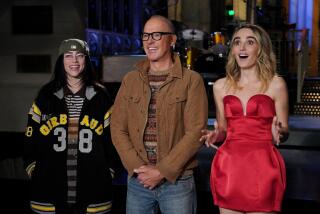Tom Snyder, one of a kind
Before he was encased in that peculiar amber known as the celebrity impersonation -- that is, before he became the late-late-night talk show host whose actual self was subsumed in Dan Aykroyd’s famous parody in the early days of “Saturday Night Live” -- Tom Snyder was an L.A. anchorman.
Snyder, who died Sunday at age 71 of complications from leukemia, arrived at KNBC-TV Channel 4 in 1970 after stints in Philadelphia and New York, 6 feet, 4 inches of oracular jocularity, the very model of the new-style, blow-dried news hero. So distinct was the mark he made here that I can only ever regard quasi-look-alike Paul Moyer as his less-resonant echo. Snyder didn’t so much deliver the news as push it out through the screen.
Although he would continue off and on to work as a newsman, it was “Tomorrow with Tom Snyder” that brought out the Snyder truly worth dressing up as and imitating. “Tomorrow,” which followed Johnny Carson’s “Tonight Show” from 1973 to 1982, was the opposite of the news environment. Depending perhaps on mood, or what he judged might put his guest at ease, Snyder might either appear in a suit and tie or in big-collared, open-necked leisure wear. But the show itself always had an unbuttoned feel; those were the days when deep late-night was still uncharted waters, before the 24-hour television clock had kicked in everywhere. It had the feel of a real after-hours show -- the initial broadcast dealt with “group marriage” -- an impression redoubled by the cigarette smoke that typically curled around Snyder’s head.
Although references to Snyder as “arrogant” and “self-indulgent” figure in many of the texts floating around the Internet since his death, in my memory and the clips available online and the DVDs in my possession, his most memorable quality as a public person was an explosive laugh that never sounded anything less than helpless and sincere. He rarely got in the way of his guests and could usually keep up his end of the conversation even when he hadn’t done his homework, because he knew how to listen and possessed a native curiosity. He didn’t mind asking questions others might have considered obvious. He never seemed to worry that he didn’t seem cool. He wasn’t cool, yet he was lovable in his (sometimes grating) way.
Although Snyder was once reportedly considered such a versatile hot property that NBC saw him as a possible network news anchor, “Today” host or Johnny Carson’s eventual replacement, the lesser career he did have was also fruitful, since it let him be himself. Work took him back and forth from New York to L.A., into talk radio and cable TV before an ultimate return to late-night network with “The Late Late Show with Tom Snyder,” which followed David Letterman on CBS from 1995 to 1998. He was hired for the job by Letterman himself, who had earlier replaced Snyder on NBC.
Snyder was something of a godsend to night owls back when the television day had an actual, and early, end. Because it was new, and because its audience was marginal and possibly little understood, late-late-night TV could hold all the strange things the rest of the schedule wouldn’t allow. “Tomorrow” was authentically late-night in a way that few other talk shows have ever managed to be. It exuded impermanence -- it was as if Snyder and crew had commandeered a couple of cameras and a soundstage after everyone else went home for the day, dragged in some chairs and invited anyone they thought might be interesting to come sit in them. Guests included John Lennon (his last TV interview), Muhammad Ali, Alfred Hitchcock, John “Johnny Rotten” Lydon, the Grateful Dead’s Jerry Garcia, Steven Spielberg and Ayn Rand.
I don’t know whether Snyder had writers on “Tomorrow,” but unlike most such hosts, he wasn’t a comic. Save for an ill-fated experiment in “variety” toward the end of its run, there was no attempt at comedy, apart from the sort of funny stories and not-always-successful jokes (usually directed toward the crew) that anyone might tell killing time before work began. There was no monologue, no cast of wacky characters, no stupid human tricks besides the ones that the guests naturally brought with them -- as when Wendy O. Williams, of the punkish Plasmatics, memorably destroyed a television, and topped it on a return engagement by demolishing a car.
That the Plasmatics had a return engagement speaks volumes.
More to Read
The complete guide to home viewing
Get Screen Gab for everything about the TV shows and streaming movies everyone’s talking about.
You may occasionally receive promotional content from the Los Angeles Times.







